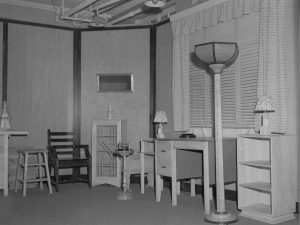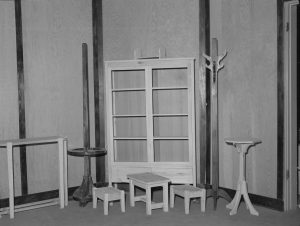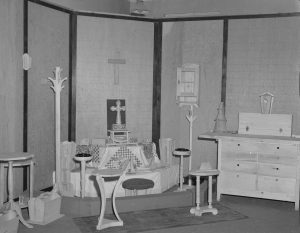10. The School of Arts and Crafts: A Way to Alleviate the Industrial Town’s Evils (1937-1961)
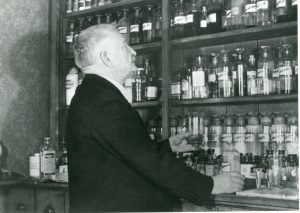
Dr. Albert I. Guertin (1873-1965), primary promoter of the first arts and crafts school in Magog. Source: Magog Historical Society, PR024 fonds Studio R.C.\album 2\photo # 310..
Although the industrialisation of Magog had enabled it to grow and modernise, industrial town evils were a major concern for a portion of the population. That was the case, for example, of the French-Canadian elite during the 1930s who worried about the future of their young people at a time marked by economic crisis, unemployment and the presence of new diversions like the cinema. Their concerns also had an impact on Magog’s educational system, particularly by bringing about the founding of the first arts and crafts school in 1939.
The School of Crafts: A way to keep young people safe from urban vices
On the one hand, because Magog was an industrial town, it was very common for children and adolescents to enter the work force. In many cases, they held down a little job in a store or found work at Dominion Textile.[1]. However, the Great Depression brought on by the 1929 stock-market crash increased unemployment. As a result, some young people found themselves simultaneously excluded from the school system and from the job market, a situation that concerned many members of the French-Canadian elite.
Consequently, Édouard Roy, chief editor of La Chronique de Magog in 1937-1938, wrote several articles advocating for the establishment of a school of crafts in Magog. The idea was to avoid idleness amongst young people who would become, according to him, more susceptible to delinquency and subjected to the negative influences of entertainment:
« [l]’imagination des jeunes [écrivait-il] ne peut demeurer inactive. Si elle n’est pas meublée avec des idées saines, si elle n’est pas fixée sur un travail, un métier, elle saisira facilement tout ce qui s’offre à elle dans les magazines ou au cinéma qui nous sert […] des films plus ou moins moraux.»[2] translation
Of course, it is difficult to measure the scope of this phenomenon and to know whether or not it was more imagined than real. Nevertheless, it is important to acknowledge that this type of discourse probably contributed to the legitimisation of a school of crafts project.
The School of Crafts: A way to better integrate boys into the work force
The school of crafts’ role was to offer technical training to adolescents as well as interested adults. It offered them a better integration into the workforce. This need was of particular concern to Dr. Albert Isidore Guertin, the project’s main architect, who thought that school was not preparing boys to confront adult life, as this journalist from La Chronique de Magog emphasized:
«Dans son plaidoyer en faveur d’une telle institution, le promoteur du projet, le Dr Guertin, a dit aux membres réunis du conseil que les jeunes filles sortent du couvent très bien outillées pour devenir des femmes, tandis que les jeunes garçons ne le sont pas.»[3] translation
Moreover, it is important to note the masculine nature of this school, evident in the words of Dr. Guertin, but also in its location (at St-Patrice Academy, a boys’ school) and in the skills that were taught (carpentry and cabinetmaking.) Evidently, more than youth, it was boys who were the target of this project.
In short, these reasons explain the opening in 1939 of the school of arts and crafts. Set up in the basement of Saint- Patrice Academy, it remained active from 1939 to 1961, when it was closed in order to enable the construction of the recreation centre.
Some of the Items Made at the School of Crafts
The oldest sources mentioning activities of students at the school are dated July 12 and 19, 1941. In two articles in La Chronique de Magog, a journalist describes in detail the first exhibition of work by the students:
« On y a admiré, notamment, des pupitres fort bien faits ainsi qu’un métier à piquer les couvrepieds que les élèves ont réalisés pour le cercle des fermières de Magog. Tables de salon délicatement tournées, petites pharmacies faites avec un beau soin, voire un traîneau d’enfant assemblé avec succès.»[4] translation
These types of projects are depicted in photographs taken in June 1947 at the request of the first teacher at the School of Crafts, Jean Chalifoux.
A Course at the School of Crafts on Percy Street
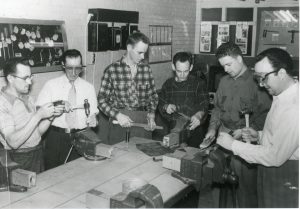
After being closed for three years, the School of Arts and Crafts re-opened on Percy Street in 1963. It closed definitively in 1986. Source: Magog Historical Society, PR002 Collection Bibliothèque Memphrémagog\album 2\photo #312.
[1] Serge Gaudreau, Au fil du temps: histoire de l’industrie textile à Magog (1883-1993), Sherbrooke, Les Productions G.G.C. Ltée, 1995, p. 69.
[2] Traduction: “The imagination of youth [he wrote] cannot remain inactive. If it is not furnished with healthy ideas, if it is not focused on a task, a craft, it will easily seize upon all that is offered to it in magazines or in cinemas that serve us […] films that are more or less moral.” Édouard Roy, (22 October 1937), Il faut un métier aux jeunes, La Chronique de Magog, p. 4.
[3] Traduction: “In his speech in support of such an institution, the project’s promoter, Dr. Guertin told members of the committee that young girls come out of the convent very well equipped to become women, while young boys are not [being prepared by schools to become men.]”Author Unknown (10 September 1937), Le Dr Guertin demande une école de métiers, La Chronique de Magog, p. 1.
[4] Traduction: “One can admire there well-constructed, sturdy desks as well as a quilting loom that the students built for the Magog Cercle des Fermières. Delicately turned living room tables, small medicine cabinets constructed with great care, even a successfully assembled child’s sleigh.” Author Unknown (19 June 1941) À l’école des arts et métiers, La Chronique de Magog, p. 1. See also Author Unknown (12 June 1941), Visite de l’exposition de l’artisanat, à Montréal, La Chronique de Magog, p. 16. Our thanks to Maurice Langlois for alerting us to the existence of these articles.


